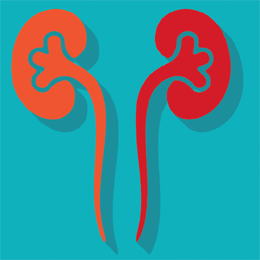
Honey Bestic, 53, of Cherry Hill, has an autoimmune disease that destroyed her liver. In 1993, she received a transplant and that liver lasted nine years. After taking immunosuppressants, both of Bestic’s kidneys began to fail alongside the liver.
In 2002, Bestic received a combination liver and kidney transplant.
While the liver held up this time, her new kidney began to fail in 2011.
“Bloodwork told the story,” says Bestic. “A biopsy revealed it was something called Transplant Glomerulopathy (TG).”
TG is common in a lot of kidney transplant patients and is generally associated with chronic antibody-mediated rejection, but is not specific to it. It could be the result of many different disease processes that affect the glomerular endothelium.
Since Bestic’s kidney was failing, she was placed on a transplant list.
“The wait for cadaver donors is, at minimum, five years,” says Bestic. “And they don’t have the longevity that live donated kidneys do. It’s a tough situation. Dialysis helps extend the lives of folks with chronic kidney disease (CKD), but it’s not a cure and there are many dangers, including potential infections, blood loss, clots, blood pressure problems and more.”
Bestic was on the kidney transplant list for three years, all the while trying her best to find a live donor who could be a match.
“Looking for a live donor is difficult, humbling and embarrassing,” says Bestic. “Anyone who considers donating a kidney tends to want to know why the potential recipient is sick in the first place. So there are some judgmental issues to deal with.”
Bestic even had to go through reading emails from potential donors who offered their help if compensation for the kidney could be provided, which is illegal. “That was always disheartening,” says Bestic.
You may have seen a news article about Bestic’s efforts in July 2014. CBS 3’s Todd Quinones reported on large car magnets that read: “Honey B Needs a kidney! We need a hero. … Could it be you?” They became the stir of Bestic’s mother’s condo complex.
The Society Hill Condo Association property manager told Bestic’s mother that they had a rule prohibiting advertising on cars that were parked outside in the complex. She, and other participants, were threatened with an initial $50 fine.
A few weeks after Quinones’ story was published, the board at the complex voted to allow the magnetic car signs.
Lots of people had been tested on Bestic’s behalf but were not a match. Two people can share the same blood type and still the possible donor can be denied due to other factors.
Although she did not find a match through the car signs, Bestic found a match closer to home.
“She had just been accepted to Hospital University of Pennsylvania’s (HUP) transplant program, and they encouraged re-testing as their standards are different,” says Jen Farley, 29, Bestic’s cousin who also lives in Cherry Hill. “I had been tested previously by a different transplant organization and was denied.”
Propitiously, Farley turned out to be the perfect match for Bestic through HUP’s transplant program.
“It was about five months of ongoing testing,” says Farley after her match was confirmed. “After an initial blood test, if you are a match and continue the testing, you donate a good part of your Wednesdays for the next three months, to more tests.
“Some of the tests include an EKG, echocardiogram, X-ray, CT scan of your kidneys, lots of blood and urine tests, glucose intolerance testing—disgusting orange drinks—and my personal favorite—24 hour urine collection—twice!” says Farley.
“As a living donor, the health screening is so extensive that if you are approved,” she says, “you actually have chances of a longer lifespan than the average person.”
“I couldn’t believe it when she told me she was a perfect match,” says Bestic. “She came in and told me while I was in dialysis.”
Bestic says she cried at the good news and, even now, still cries when she thinks about it.
Surgery was scheduled for Oct. 6, 2015 and, to be expected, Farley was very nervous.
“I was terrified,” says Farley. “In fact, the few minutes before surgery, the nurse could not get my IV in because I was shaking so bad. They had to give me some sedatives so I would calm the heck down enough for them to set me up properly. I wasn’t scared until I had the surgery gown on.”
The kidney transplant was successful and Bestic is doing great. Farley says the surgeon told her she gave a “super kidney.”
“Believe it or not, it started producing urine for Honey before they had even closed her up from surgery,” she says.
Both of the women agree that Farley’s recovery was a bit harsher. Bestic explains it as she was being taken from a state of illness to a state of health, while Farley had gone through the opposite.
“They actually go in laproscopically and disconnect the organ, but to get it out they make an incision right down the middle of your belly and stick their hand in there to grab it,” says Farley. “They have to move all your good stuff (bowels) out of the way and bowels are very unhappy about that sort of thing. They also use gas to inflate you, so when you recover it’s just gas pain, bloating, lots of pain and swelling.”
Farley says the first few days were very miserable, but once she got over that hump and the gas dissipated, it was just like any other surgery recovery.
It has been six months since the surgery and Bestic still finds it hard to believe that Farley offered up one of her kidneys after finding out she was a match.
“Every day is a gift, and I am so thrilled not to be tethered to a machine anymore,” says Bestic.
As for Farley, there has been one steady thought in her mind since the surgery, “I would do it again it a heartbeat.”
Published (and copyrighted) in South Jersey Magazine, Volume 13, Issue 1 (April, 2016).
For more info on South Jersey Magazine, click here.
To subscribe to South Jersey Magazine, click here.
To advertise in South Jersey Magazine, click here.











